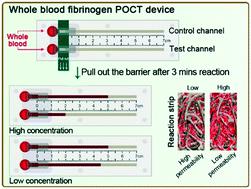Our official English website, www.x-mol.net, welcomes your
feedback! (Note: you will need to create a separate account there.)
A point-of-care microfluidic channel-based device for rapid and direct detection of fibrinogen in whole blood
Lab on a Chip ( IF 6.1 ) Pub Date : 2022-06-15 , DOI: 10.1039/d2lc00437b Qinan Ban 1, 2 , Yulong Zhang 1 , Yuxuan Li 1 , Daye Cao 3 , Weifeng Ye 4 , Linsheng Zhan 1, 2 , Daming Wang 3, 5 , Xiaohui Wang 1
Lab on a Chip ( IF 6.1 ) Pub Date : 2022-06-15 , DOI: 10.1039/d2lc00437b Qinan Ban 1, 2 , Yulong Zhang 1 , Yuxuan Li 1 , Daye Cao 3 , Weifeng Ye 4 , Linsheng Zhan 1, 2 , Daming Wang 3, 5 , Xiaohui Wang 1
Affiliation

|
Hemorrhage is the leading cause of preventable death in civilian and battlefield traumatic injuries. Patients with severe traumatic hemorrhagic shock are more likely to be deficient in fibrinogen than those with other coagulation factors, and hypofibrinogenemia is an independent risk factor for mortality. Thus, rapid detection of fibrinogen levels is of great importance in these patients during damage control resuscitation. Plasma is used as an analyte in fibrinogen detection, which restricts the use of existing devices in emergencies. To meet the needs of on-site detection, we developed a point-of-care microfluidic channel-based device for direct measurement of fibrinogen concentration in whole blood. In our method, thrombin is dispersed on a reaction strip to initiate conversion of fibrinogen to fibrin. The permeability of the resulting blood clots depends on the fibrinogen level. A hydrophobic plastic protection flake between the reaction strip and a wicking strip is then removed to allow flow of unclotted blood. The rate of blood flow along the wicking strip was inversely related to the fibrinogen concentration. The whole process could be completed in as fast as 5 minutes for a whole blood sample size of 150 μL, and yielded accurate results ranging from 0 to 4 g L−1, which were unaffected by Ca2+, blood lipids, hematocrit, warfarin and tissue plasminogen activators (tPAs). Results using clinical whole blood samples were also highly consistent with those using an automatic coagulation analyzer, yielding a Pearson correlation coefficient of up to 0.919. This approach has potential for allowing rapid diagnosis of fibrinogen concentration in critically ill bleeding patients in different settings, thus helping to judge the suitability of fibrinogen replacement therapy (FRT) in cases of emergency bleeding and in patients at risk of thrombosis due to hyperfibrinogenemia.
中文翻译:

一种基于即时微流控通道的装置,用于快速直接检测全血中的纤维蛋白原
出血是平民和战场外伤造成可预防死亡的主要原因。与其他凝血因子患者相比,严重创伤性失血性休克患者更容易缺乏纤维蛋白原,而低纤维蛋白原血症是死亡的独立危险因素。因此,在这些患者的损伤控制复苏过程中,快速检测纤维蛋白原水平非常重要。血浆被用作纤维蛋白原检测的分析物,这限制了现有设备在紧急情况下的使用。为了满足现场检测的需要,我们开发了一种基于即时微流体通道的装置,用于直接测量全血中的纤维蛋白原浓度。在我们的方法中,凝血酶分散在反应条上以启动纤维蛋白原向纤维蛋白的转化。产生的血凝块的渗透性取决于纤维蛋白原水平。然后去除反应条和芯条之间的疏水塑料保护薄片以允许未凝结的血液流动。沿着芯条的血流速率与纤维蛋白原浓度成反比。对于 150 μL 的全血样本,整个过程最快可在 5 分钟内完成,并产生从 0 到 4 g L 范围内的准确结果-1,不受Ca 2+、血脂、血细胞比容、华法林和组织纤溶酶原激活剂(tPAs)的影响。使用临床全血样本的结果也与使用自动凝血分析仪的结果高度一致,皮尔逊相关系数高达 0.919。这种方法有可能在不同情况下快速诊断危重出血患者的纤维蛋白原浓度,从而有助于判断纤维蛋白原替代疗法 (FRT) 在紧急出血情况下和因高纤维蛋白原血症而有血栓形成风险的患者中的适用性。
更新日期:2022-06-15
中文翻译:

一种基于即时微流控通道的装置,用于快速直接检测全血中的纤维蛋白原
出血是平民和战场外伤造成可预防死亡的主要原因。与其他凝血因子患者相比,严重创伤性失血性休克患者更容易缺乏纤维蛋白原,而低纤维蛋白原血症是死亡的独立危险因素。因此,在这些患者的损伤控制复苏过程中,快速检测纤维蛋白原水平非常重要。血浆被用作纤维蛋白原检测的分析物,这限制了现有设备在紧急情况下的使用。为了满足现场检测的需要,我们开发了一种基于即时微流体通道的装置,用于直接测量全血中的纤维蛋白原浓度。在我们的方法中,凝血酶分散在反应条上以启动纤维蛋白原向纤维蛋白的转化。产生的血凝块的渗透性取决于纤维蛋白原水平。然后去除反应条和芯条之间的疏水塑料保护薄片以允许未凝结的血液流动。沿着芯条的血流速率与纤维蛋白原浓度成反比。对于 150 μL 的全血样本,整个过程最快可在 5 分钟内完成,并产生从 0 到 4 g L 范围内的准确结果-1,不受Ca 2+、血脂、血细胞比容、华法林和组织纤溶酶原激活剂(tPAs)的影响。使用临床全血样本的结果也与使用自动凝血分析仪的结果高度一致,皮尔逊相关系数高达 0.919。这种方法有可能在不同情况下快速诊断危重出血患者的纤维蛋白原浓度,从而有助于判断纤维蛋白原替代疗法 (FRT) 在紧急出血情况下和因高纤维蛋白原血症而有血栓形成风险的患者中的适用性。











































 京公网安备 11010802027423号
京公网安备 11010802027423号